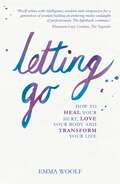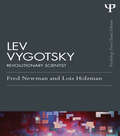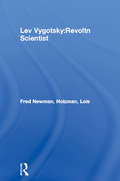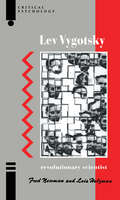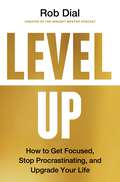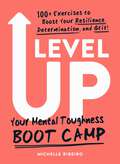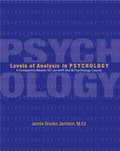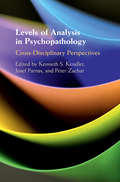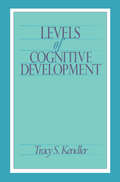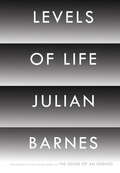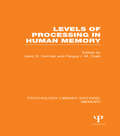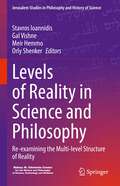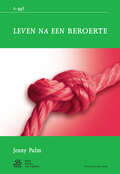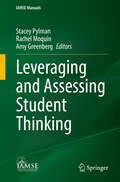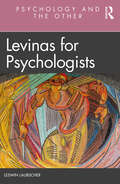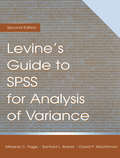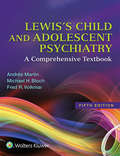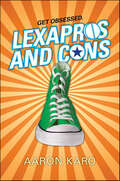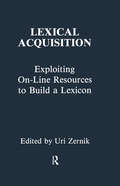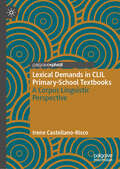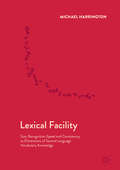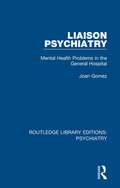- Table View
- List View
Letting Go: How to Heal Your Hurt, Love Your Body and Transform Your Life
by Emma WoolfExploring the issues of love, loss, healing and happiness, this manifesto for freedom from one of feminism’s liveliest voices will guide you on the path to feeling newly, truly confident.
Letting Go: Surrender Trilogy Book 1 (Surrender)
by Maya BanksFor fans of E. L. James, Sylvia Day, J. Kenner and Meredith Wild. Are you ready to surrender to the powerful sensuality and erotic romance of No. 1 New York Times bestselling author Maya Banks and her sensational trilogy?Josslyn found perfection once; she knows she'll never find it again. Now widowed, she seeks the one thing her beloved husband couldn't give her: dominance. But at an exclusive club which indulges the most hedonistic of fantasies, she never imagined she'd find the one man who's long been a source of comfort - her husband's best friend.Dash has lived in an untenable position for years: in love with his best friend's wife but unwilling to act on that attraction. When he finds her in a club devoted to the darker edges of desire, he thinks she has no idea what she's getting herself into. Until she explains in detail what she wants. What she needs. If she wants dominance, he is the only man who will introduce her to that world. He is the only man who will touch her, cherish her...love her. And the only man she'll ever submit to.The exciting, steamy and emotional Surrender trilogy continues with Giving In and Taking It All.
Lev Vygotsky: Revolutionary Scientist (Psychology Press & Routledge Classic Editions)
by Fred Newman Lois HolzmanWhen Lev Vygotsky: Revolutionary Scientist published, it was unique in several ways. It presented Vygotsky as a Marxist methodologist, both locating him in his historical period and delineating how his life and writings have been a catalyst for a contemporary revolutionary, practical-critical, psychology. It highlighted Vygotsky’s unconventional view of how development and learning are related and, in doing so, brought human development into prominence. It introduced important linkages between Vygotsky’s views on thinking and speaking and those of Wittgenstein, drawing implications for language acquisition and language learning. And it drew attention to Vygotsky’s understanding of the role of play in child development, and expanded on the significance of play throughout the lifespan. In these ways, this classic text presented a more expansive Vygotsky than previously understood. The Introduction to this Classic Edition will summarize what has transpired in the years since Lev Vygotsky first published. It will answer who and where is Vygotsky now? What place does he have in scholarship in psychology, education, and other fields? How are practitioners making use of him—to address the challenges of our times, solve seemingly intractable social problems, revolutionize psychology, and develop skilled and worldly citizens? What have the authors accomplished since they first articulated their view of Vygotsky as a revolutionary scientist?
Lev Vygotsky: Revolutionary Scientist (Psychology Press And Routledge Classic Editions Ser.)
by Fred Newman Lois HolzmanFirst Published in 1993. Routledge is an imprint of Taylor & Francis, an informa company.
Lev Vygotsky: Revolutionary Scientist (Psychology Press And Routledge Classic Editions Ser.)
by Fred Newman Lois HolzmanLev Vygotsky was one of the most talented and brilliant of Soviet psychologists. Despite his tragically early death at the age of 38 his accomplishments are enormously impressive: he played a key role in restructuring the Psychological Institute of Moscow; set up two research laboratories in the major cities of the USSR; founded what we call special education; and authored some 180 works. His innovative theories of thought and speech are important not just for psychology but for other disciplines also. Yet even though his ideas have increasingly won popularity there remains a strong need for an accessible introduction to the man and his work. In Lev Vygotsky: Revolutionary Scientist Lois Holzman and Fred Newman have written a clear introductory text suitable for undergraduate students. In so doing they have taken the opportunity to set straight the misunderstandings and misuses of Vygotsky's ideas. and his work.
Level Up: How to Get Focused, Stop Procrastinating, and Upgrade Your Life
by Rob Dial“Packed with valuable insights, unique lessons, and practical steps, this book will help you break through your procrastination and take immediate action toward your goals.”—Jay Shetty, New York Times bestselling author of Think Like a Monk and 8 Rules of LoveLevel Up will revolutionize the way you approach your life and your goals. This book from world-renowned high-performance coach and host of The Mindset Mentor podcast, Rob Dial, presents a groundbreaking roadmap to unlock your full potential and transform your life. In it, you will find:A transformative system designed to revolutionize the way you approach your goals, success, and personal motivation.Powerful secrets of highly successful individuals who have mastered the art of focus, defeated their procrastination, and achieved extraordinary results.Cutting-edge research in neuroscience and psychology, unveiling the science behind mental focus and motivation.Tools that empower you to understand and control your mind like never before. This book has cracked the code to peak performance and you will learn how to apply these secrets to your own life. Level Up is not just another self-help book. It is a step-by-step guide that helps you get from where you are now to the life you truly want to be as fast as possible.Whether you're struggling with distractions, overwhelmed by a chaotic schedule, or simply seeking a path to personal excellence, Level Up is the game-changer you've been waiting for.
Level Up: Your Mental Toughness Boot Camp
by Michelle RibeiroReach your peak psychological potential with these 120 activities that challenge and build emotional strength, flexibility, and resiliency so you can overcome any obstacle.Mental toughness no longer has to be reserved for Navy Seals, world-class athletes, or high-powered CEOs. Now you can also experience this trait to help you succeed and reach your peak potential. You can train yourself to take on these challenges with ease. In Level Up, learn how to tackle any obstacle with composure, clear thinking, and dexterity. This activity-based book builds your mental strength through 120 exercises, prompts, quizzes, and more. These exercises will help you increase your mental focus, emotional resiliency, and psychological agility, all of which allow you to constantly evaluate where you are and keep pushing you closer to your goals. Work through your aspirations without getting bogged down by the obstacles and experience mental toughness—no matter how hard things get.
Levels of Analysis in Psychology: A Companion Reader for Use with the IB Psychology Course
by Jennie Brooks JamisonThis book supplements an introductory psychology text with up-to-date, in-depth information relevant to the IB syllabus.
Levels of Analysis in Psychopathology: Cross-Disciplinary Perspectives
by Peter Zachar Kenneth S. Kendler Josef ParnasLevels of Analysis in Psychopathology draws research from psychiatry, philosophy, and psychology to explore the variety of explanatory approaches for understanding the nature of psychiatric disorders both in practice and research. The fields of psychiatry and clinical psychology incorporates many useful explanatory approaches and this book integrates this range of perspectives and makes suggestions about how to advance etiologic theories, classification, and treatment. The editors have brought together leading thinkers who have been widely published and are well-respected in their area of expertise, including several developers of the Diagnostic and Statistical Manual of Mental Disorders and authors of the US National Institute of Mental Health's Research Domain Criteria Project (RDoC). Each main chapter has a commentary provided by one of the other authors and an introduction written by one of the editors to create an accessible, interdisciplinary dialog.
Levels of Cognitive Development
by Tracy S. KendlerThe proposed levels theory presented in this book concerns some developmental changes in the capacity to selectively encode information and provide rational solutions to problems. These changes are measured by the behavior exhibited in simple discrimination-learning problems that allow both for information to be encoded either selectively or nonselectively and for solutions to be produced by associative learning or by hypothesis-testing. The simplicity of these problems permits comparisons between infrahuman and human performance and also between a wide range of ages among humans. Human adults presented with these problems typically encode the relevant information selectively and solve the problems in a rational mode. Infrahuman animals, however, typically process the information nonselectively and solve the problems in an automatic, associative mode. How human children encode the information and solve the problems depends on their age. The youngest children -- like the infrahuman animals -- mostly encode the information nonselectively and solve the problems in the associative mode. But between early childhood and young adulthood there is a gradual, long-term, quantifiable increase in the tendency to encode the information selectively and to solve the problem by testing plausible hypotheses. The theory explains in some detail the structure, function, development, and operation of the psychological system that produces both the ontogenetic and phylogenetic differences. This system is assumed to be differentiated into an information-processing system and an executive system analogous to the differentiation of the nervous system into afferent and efferent systems. Each of these systems is further differentiated into structural levels, with the higher level, in part, duplicating the function of the lower level, but in a more plastic, voluntary, and efficient manner. The differentiation of the information-processing and executive systems into different functional levels is presumed to have occurred sometime during the evolution of mankind with the higher level evolving later than the lower one as the central nervous system became increasing encephalized. As for human ontogeny, the higher levels are assumed to develop later and more slowly than their lower-level counterparts. In addition to accounting for a substantial body of empirical data, the theory resolves some recurrent controversies that have bedeviled psychology since its inception as a science. It accomplishes this by showing how information can be both nonselectively and selectively encoded, how automatic associative learning and rational problem-solving can operate in harmony, and how cognitive development can be both qualitative and quantitative.
Levels of Life (Vintage International Series)
by Julian BarnesPart history, part fiction, part memoir, Levels of Life is a powerfully personal and unforgettable book, and an immediate classic on the subject of grief. Levels of Life opens in the nineteenth century with balloonists, photographers, and Sarah Bernhardt, whose adventures lead seamlessly into an entirely personal account of the author's own great loss. "You put together two things that have not been put together before. And the world is changed..." Julian Barnes's new book is about ballooning, photography, love and grief; about putting two things, and two people, together, and about tearing them apart. One of the judges who awarded him the 2011 Man Booker Prize described Barnes as "an unparalleled magus of the heart." This book confirms that opinion.
Levels of Personality
by Mark CookA completely revised and updated edition of a much-acclaimed textbook providing a critical introduction to human personality for psychology students. Levels of Personality carefully avoids the traditional 'catalogue of theories' approach. Instead it relates theories to each other within a conceptual framework of different levels of behaviour, moving inwards and downwards from 'surface level' explanations. Analytic case studies then apply these levels of understanding to areas of special interest such as aggression and sexuality. The author adopts a deep analytical and critical approach and questions whether personality theory and research have really addressed important questions, or produced useful answers. This new edition incorporates two new chapters on personality disorders and on personality in the workplace, as well as improved pedagogical features including statistics boxes, assessment boxes, relevant websites and key references for each chapter.
Levels of Processing in Human Memory (Psychology Library Editions: Memory)
by Laird S. Cermak Fergus I. M. CraikAs a conceptual framework for the investigation of human memory, the levels-of-processing paradigm had enjoyed immense popularity since its introduction in the early 1970s. It was the impetus behind literally hundreds of experiments and was used as an "explanation" for a wide range of retention phenomena. Consequently, a wealth of data and theory had emerged, and this title assimilates and evaluates this information. Originally published in 1979, the distinguished contributors to the volume – both proponents and opponents of the levels-of-processing framework – present here their latest data and ideas on a viewpoint that has been a tremendous influence in memory research and related areas.
Levels of Reality in Science and Philosophy: Re-examining the Multi-level Structure of Reality (Jerusalem Studies in Philosophy and History of Science)
by Meir Hemmo Orly Shenker Stavros Ioannidis Gal VishneThis book offers a unique perspective on one of the deepest questions about the world we live in: is reality multi-leveled, or can everything be reduced to some fundamental ‘flat’ level? This deep philosophical issue has widespread implications in philosophy, since it is fundamental to how we understand the world and the basic entities in it. Both the notion of ‘levels’ within science and their ontological implications are issues that are underexplored in the philosophical literature. The volume reconsiders the view that reality contains many levels and opens new ways to understand the ontological status of the special sciences. The book focuses on major open questions that arise at the foundations of cognitive science, cognitive psychology, brain science and other special sciences, in particular with respect to the physical foundations of these sciences. For example: Is the mental computational? Do brains compute? How can the special sciences be autonomous from physics, grounded in, or based on, physics and at the same time irreducible to physics? The book is an important read for scientists and philosophers alike. It is of interest to philosophers of science, philosophers of mind and biology interested in the notion of levels, but also to psychologists, cognitive scientists and neuroscientists investigating such issues as the precise relation of the mental to the underlying neural structures and the appropriate approach to study it.
Leven na een beroerte
by J. PalmDit boek gaat over de psychologische en neuropsychologische gevolgen van een beroerte: wat betekent het voor je leven wanneer je opeens geconfronteerd wordt met de gevolgen van een beroerte. Het boek geeft uitleg over specifieke problemen, en wat je eraan kunt doen. De problemen worden schematisch behandeld, zodat gemakkelijk op te zoeken is wat verwacht kan worden na een bepaald type beroerte.
Leveraging and Assessing Student Thinking (IAMSE Manuals)
by Amy Greenberg Stacey Pylman Rachel MoquinThis book is a compilation of teaching theories and strategies for eliciting and interpreting student thinking to adapt to educational settings. Medical education is no longer about simply providing students with knowledge, as it was in Flexner’s day. Modern medical education is focused on shaping how students understand, define, and move the practice of medicine forward. Modern medical schools focus on building student’s ability to reason clinically and develop their own identity as professionals while integrating those pieces of their identity with their emerging content knowledge. This level of high-quality education requires medical educators to understand their learners and see their learners as more than repositories for knowledge. A medical educator must understand who the learner is, what the learner already knows, and what misunderstandings the learner has. Hence, educators must learn to be skilled not simply at conveying information, but rather at eliciting student thinking and understanding to discern what and how to best teach the learner. Faculty often think of teaching this way as complex and time-consuming. However, in this manual we reveal that once the theoretical underpinnings of why leveraging and assessing student thinking matters are understood, educators can enact the theory by building specific teaching skills. This manual is written by authors steeped in educational theory and with a background in teacher education. Other manuals and book chapters have looked at active learning and rubrics which are part of learner-centered instruction. This manual is the first of its kind to help medical educators practice what it means to teach in a learner-centered way by leveraging student thinking. The manual is written using educational theory and literature, includes vignettes for illustrative purpose, and provides practical steps in enacting strategies to elicit student thinking. In the first section of this manual, we define the practices of eliciting and interpreting student thinking and explain why student thinking matters, introduce readers to gradual release theories of learning, and showcase the benefits of using students’ experiences, background, and prior knowledge. In the second section of the manual, we explain in further detail how to leverage and assess student thinking. We describe, illustrate with vignettes, and provide step by step guides on the skills of questioning, giving feedback, debriefing clinical experiences, analyzing student work, and assessing student thinking and understanding in the medical education context.
Levinas for Psychologists (Psychology and the Other)
by Leswin LaubscherLevinas for Psychologists provides a rigorous, yet accessible, examination of Emmanuel Levinas’s philosophy and its implications for psychology and the human and social sciences. Comprehensive in scope, this book traces Levinas’s thought across the arc of his oeuvre, from the earliest works to the last interviews and essays. Laubscher provides numerous examples of how Levinas’s thought challenges current clinical and psychotherapeutic work, psychological theory, social science research, and social theory but also offers promising alternatives. Such alternative ways to think and practice psychology are richly illuminated by accessible examples from therapy, research, and the social everyday. The volume makes Levinas’s dense and demanding philosophical language comprehensible and accessible, without losing the radical, profound, and poetic qualities of the original. Issues of justice, racism, and nature are addressed throughout, and these insights and conclusions are placed within a contemporary context. This book is essential reading for psychologists, philosophers, and anyone interested in the legacy of Levinas’s work.
Levine's Guide to SPSS for Analysis of Variance
by Sanford L. Braver David P. MacKinnon Melanie PageA greatly expanded and heavily revised second edition, this popular guide provides instructions and clear examples for running analyses of variance (ANOVA) and several other related statistical tests of significance with SPSS. No other guide offers the program statements required for the more advanced tests in analysis of variance. All of the programs in the book can be run using any version of SPSS, including versions 11 and 11.5. A table at the end of the preface indicates where each type of analysis (e.g., simple comparisons) can be found for each type of design (e.g., mixed two-factor design). <P><P> Providing comprehensive coverage of the basic and advanced topics in ANOVA, this is the only book available that provides extensive coverage of SPSS syntax, including the commands and subcommands that tell SPSS what to do, as well as the pull-down menu point-and-click method (PAC). Detailed explanation of the syntax, including what is necessary, desired, and optional helps ensure that users can validate the analysis being performed. The book features the output of each design along with a complete explanation of the related printout. <P><P> The new edition was reorganized to provide all analysis related to one design type in the same chapter. It now features expanded coverage of analysis of covariance (ANCOVA) and mixed designs, new chapters on designs with random factors, multivariate designs, syntax used in PAC, and all new examples of output with complete explanations. The new edition is accompanied by a CD-ROM with all of the book's data sets, as well as exercises for each chapter. This book is ideal for readers familiar with the basic concepts of the ANOVA technique including both practicing researchers and data analysts, as well as advanced students learning analysis of variance.
Lewis's Child and Adolescent Psychiatry: A Comprehensive Textbook
by Fred R. Volkmar Andrés Martin Michael H. BlochFor 25 years, Lewis's Child and Adolescent Psychiatry has been the cornerstone of every child and adolescent psychiatrist’s library. Now, three colleagues of Dr. Lewis at the world-renowned Yale Child Study Center, have substantially updated and revised this foundational textbook for its long-awaited fifth edition, the first in ten years. Encyclopedic in scope, it continues to serve as a broad reference, deftly encompassing and integrating scientific principles, research methodologies, and everyday clinical care.
Lexapros and Cons
by Aaron KaroChuck Taylor's OCD has rendered him a high school outcast. His endless routines and habitual hand washing threaten to scare away both his closest friend and the amazing new girl in town. Sure he happens to share the name of the icon behind the coolest sneakers in the world, but even Chuck knows his bizarre system of wearing different color "Cons" depending on his mood is completely crazy. In this hilariously candid debut novel from comedian Aaron Karo—who grew up with a few obsessions and compulsions of his own—very bad things are going to happen to Chuck. But maybe that's a good thing. Because with graduation looming, Chuck finds himself with one last chance to face his inner demons, defend his best friend, and win over the girl of his dreams. No matter what happens, though, he'll have to get his hands dirty.
Lexical Acquisition: Exploiting On-line Resources To Build A Lexicon
by Uri ZernikOn-line information -- and free text in particular -- has emerged as a major, yet unexploited, resource available in raw form. Available, but not accessible. The lexicon provides the major key for enabling accessibility to on-line text. The expert contributors to this book explore the range of possibilities for the generation of extensive lexicons. In so doing, they investigate the use of existing on-line dictionaries and thesauri, and explain how lexicons can be acquired from the corpus -- the text under investigation -- itself. Leading researchers in four related fields offer the latest investigations: computational linguists cover the natural language processing aspect; statisticians point out the issues involved in the use of massive data; experts discuss the limitations of current technology; and lexicographers share their experience in the design of the traditional dictionaries.
Lexical Conflict
by Danko ŠipkaThe first practical study of its kind, Lexical Conflict presents a taxonomy of cross-linguistic lexical differences, with thorough discussion of zero equivalence, multiple equivalence and partial equivalence across languages. Illustrated with numerous examples taken from over one hundred world languages, this work is an exhaustive exploration of cross-linguistic and cross-cultural differences, and presents guidelines and solutions for the lexicographic treatment of these differences. The text combines theoretical and applied linguistic perspectives to create an essential guide for students, researchers and practitioners in linguistics, anthropology, cross-cultural psychology, translation, interpretation and international marketing.
Lexical Demands in CLIL Primary-School Textbooks: A Corpus Linguistic Perspective
by Irene Castellano-RiscoThis book provides an examination of the academic language found in Content and Language Integrated Learning (CLIL) primary-school written input, with a focus on the lexical demands of CLIL textbooks. CLIL is understood as the teaching of content subjects through an additional or foreign language. Under the CLIL approach, learners are asked to understand new concepts and ideas, while processing input that is unlikely to be comprehended without a broad L2 vocabulary knowledge. Within the total amount of L2 input they may receive, textbooks play a central role, as they are usually employed as guide for teachers and learners alike to vertebrate the curriculum. In this book the author focuses on the nature of the English textbooks to which CLIL learners are exposed and identifies the main lexical demands found in these texts. Following a corpus-based methodology, it analyses a corpus of 1.5 million words comprising CLIL primary-school textbooks from four disciplines: Arts & Crafts, Music, Natural Science and Social Science (Geography and History). This data-driven analysis explores the lexical demands posed by CLIL textbooks in each of these disciplines and offers a comparative exploration of these demands across subject areas and academic years. The volume will be of interest to researchers and practitioners interested in the linguistic implications of the application of a CLIL approach, including those with backgrounds in TESOL, Applied Linguistics, Curriculum and Materials Development, Second Language Acquisition and Language Education.
Lexical Facility
by Michael HarringtonThis book examines the simultaneous contribution of learner vocabulary size and speed to second language performance differences across learner levels and settings. Harrington considers vocabulary size and speed, as reflected in retrieval speed and consistency, as a three-dimensional measurement construct termed lexical facility. While size and retrieval speed are generally known, this is the first attempt to incorporate consistency, as measured by the coefficient of variation, as an index of vocabulary skill. Part 1 describes the three dimensions and the roles they play on lower level text processing and thus on second language performance more generally. Part 2 reports on seven studies and related research that investigate the sensitivity of the three dimensions, both individually and in combination, to proficiency differences in common domains of academic English performance. Harrington's framework and the theoretical and methodological issues that arise are presented in a manner accessible to a wide readership, including second language acquisition vocabulary researchers, testing and assessment practitioners, and those interested in second language research methodology.
Liaison Psychiatry: Mental Health Problems in the General Hospital (Routledge Library Editions: Psychiatry #9)
by Joan GomezLiaison psychiatry, that is, psychiatry with patients with organic disorders or physical symptoms in general hospitals, is a field that grew rapidly in the 1980s. Yet there had been no introductory book to the subject which might have served the needs of trainee psychiatrists, medical students, and general physicians and surgeons, as well as nurses and others, whose patients might be involved. This book, originally published in 1987, aimed to fill this gap in the literature. It begins by examining the scope and organisational issues of liaison psychiatry at the time and its role in psychiatric patients with organic disease, psychosomatic disorders, emotional reactions to physical disease, terminal illness, etc. The bulk of the book then reviews liaison in a range of medical specialities. The book should thus have a wide readership.
